Auditing Theory and Practice (ACCT6006) Case Study Report: Analysis
VerifiedAdded on 2022/09/16
|12
|2858
|15
Report
AI Summary
This report provides a detailed analysis of auditing theory and practice, based on three case studies. The first case study examines inherent audit risk factors and the determination of preliminary materiality levels for MaxSecurity Limited, a company in a complex manufacturing industry. The second case study focuses on debtor confirmation procedures, evaluating the strengths and weaknesses of this technique in the context of MSMG, considering the materiality of trade receivables and the impact of overdue accounts. The third case study explores ethical considerations in auditing, specifically addressing the ethical principles of APES 110 and potential threats to audit independence in a scenario involving Champion Securities, including the actions Meg can take to comply with ethical standards and the types of audit opinions that can be issued. The report concludes with recommendations for addressing the ethical dilemmas presented in the final case study.
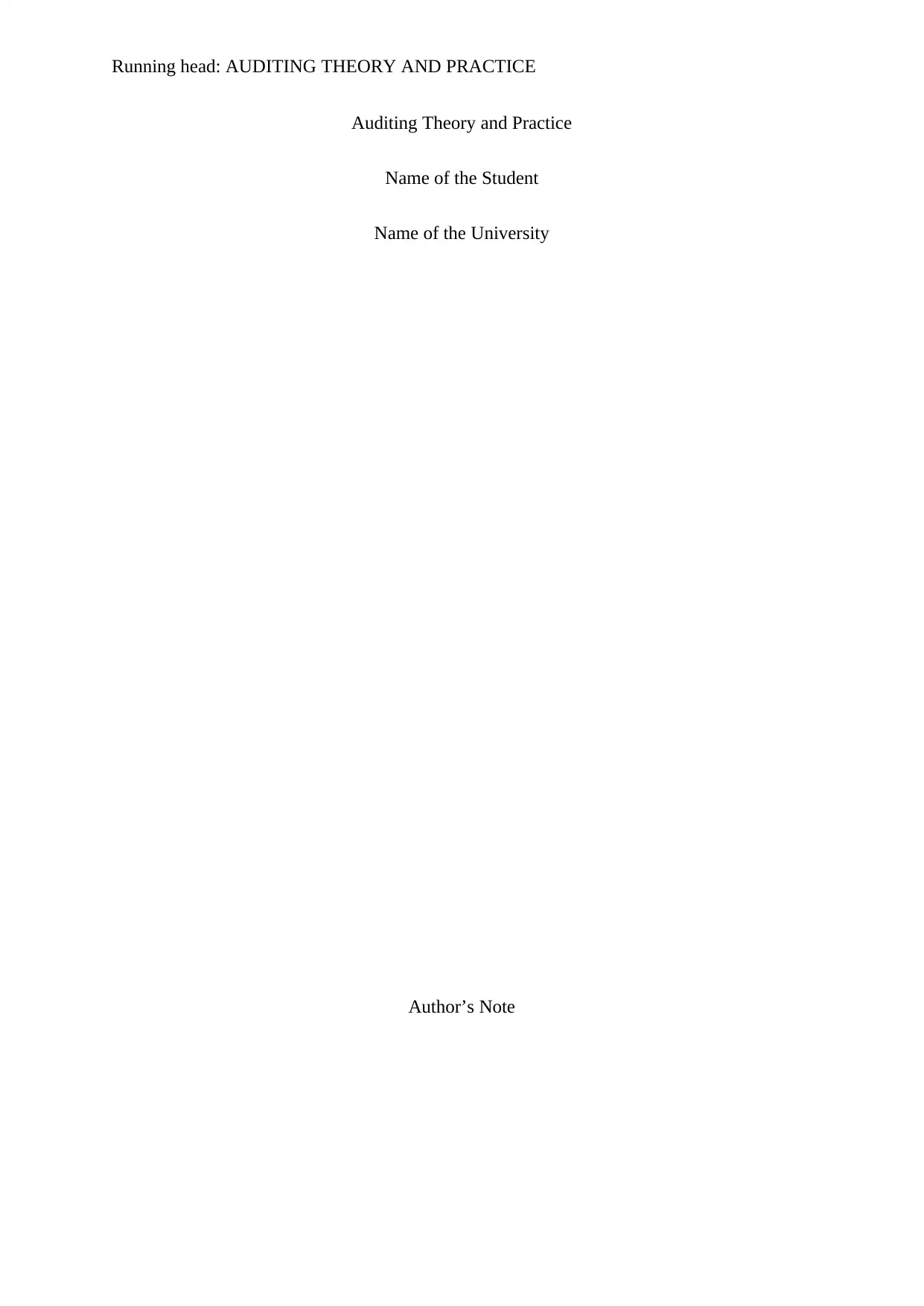
Running head: AUDITING THEORY AND PRACTICE
Auditing Theory and Practice
Name of the Student
Name of the University
Author’s Note
Auditing Theory and Practice
Name of the Student
Name of the University
Author’s Note
Paraphrase This Document
Need a fresh take? Get an instant paraphrase of this document with our AI Paraphraser
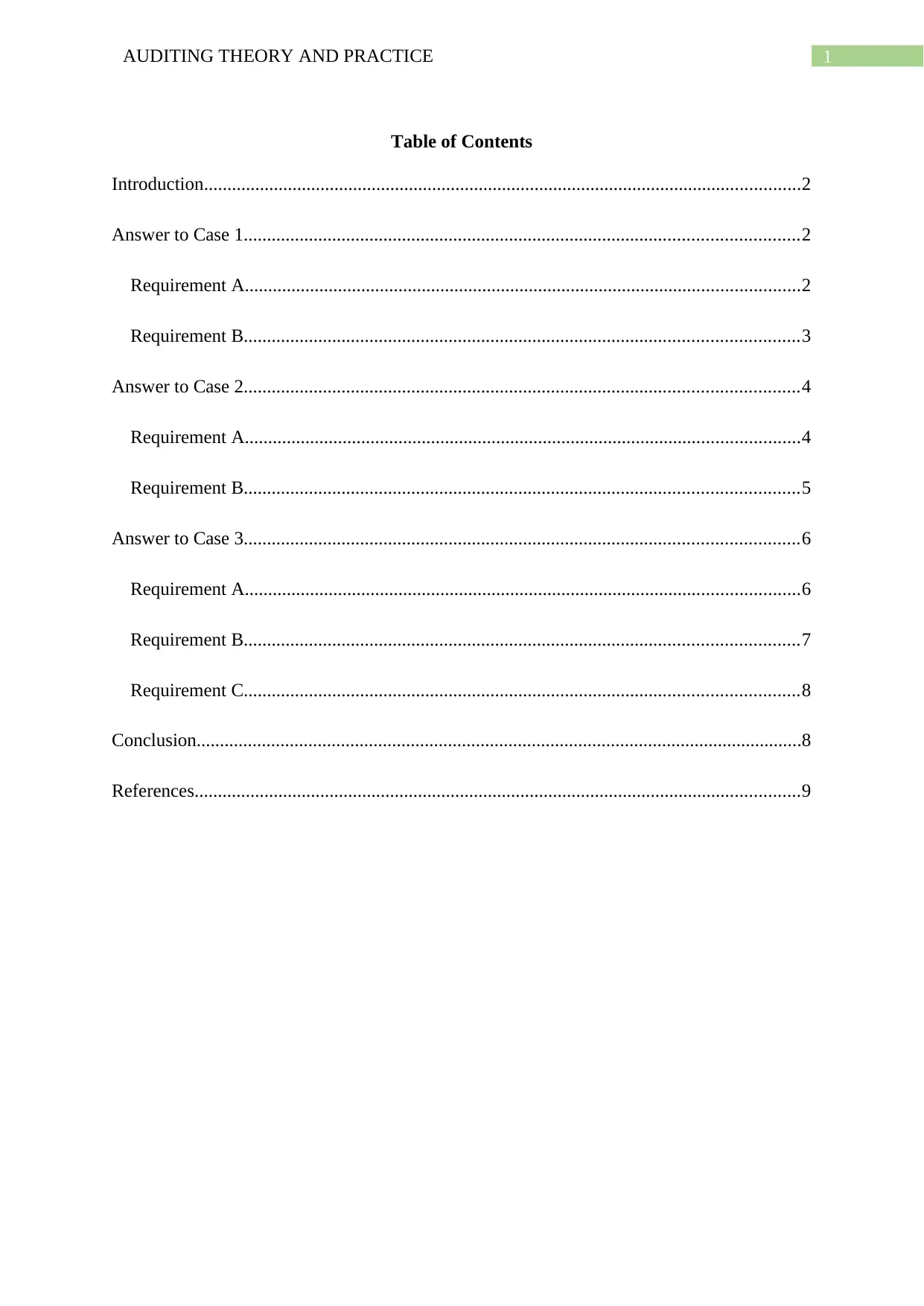
1AUDITING THEORY AND PRACTICE
Table of Contents
Introduction................................................................................................................................2
Answer to Case 1.......................................................................................................................2
Requirement A.......................................................................................................................2
Requirement B.......................................................................................................................3
Answer to Case 2.......................................................................................................................4
Requirement A.......................................................................................................................4
Requirement B.......................................................................................................................5
Answer to Case 3.......................................................................................................................6
Requirement A.......................................................................................................................6
Requirement B.......................................................................................................................7
Requirement C.......................................................................................................................8
Conclusion..................................................................................................................................8
References..................................................................................................................................9
Table of Contents
Introduction................................................................................................................................2
Answer to Case 1.......................................................................................................................2
Requirement A.......................................................................................................................2
Requirement B.......................................................................................................................3
Answer to Case 2.......................................................................................................................4
Requirement A.......................................................................................................................4
Requirement B.......................................................................................................................5
Answer to Case 3.......................................................................................................................6
Requirement A.......................................................................................................................6
Requirement B.......................................................................................................................7
Requirement C.......................................................................................................................8
Conclusion..................................................................................................................................8
References..................................................................................................................................9
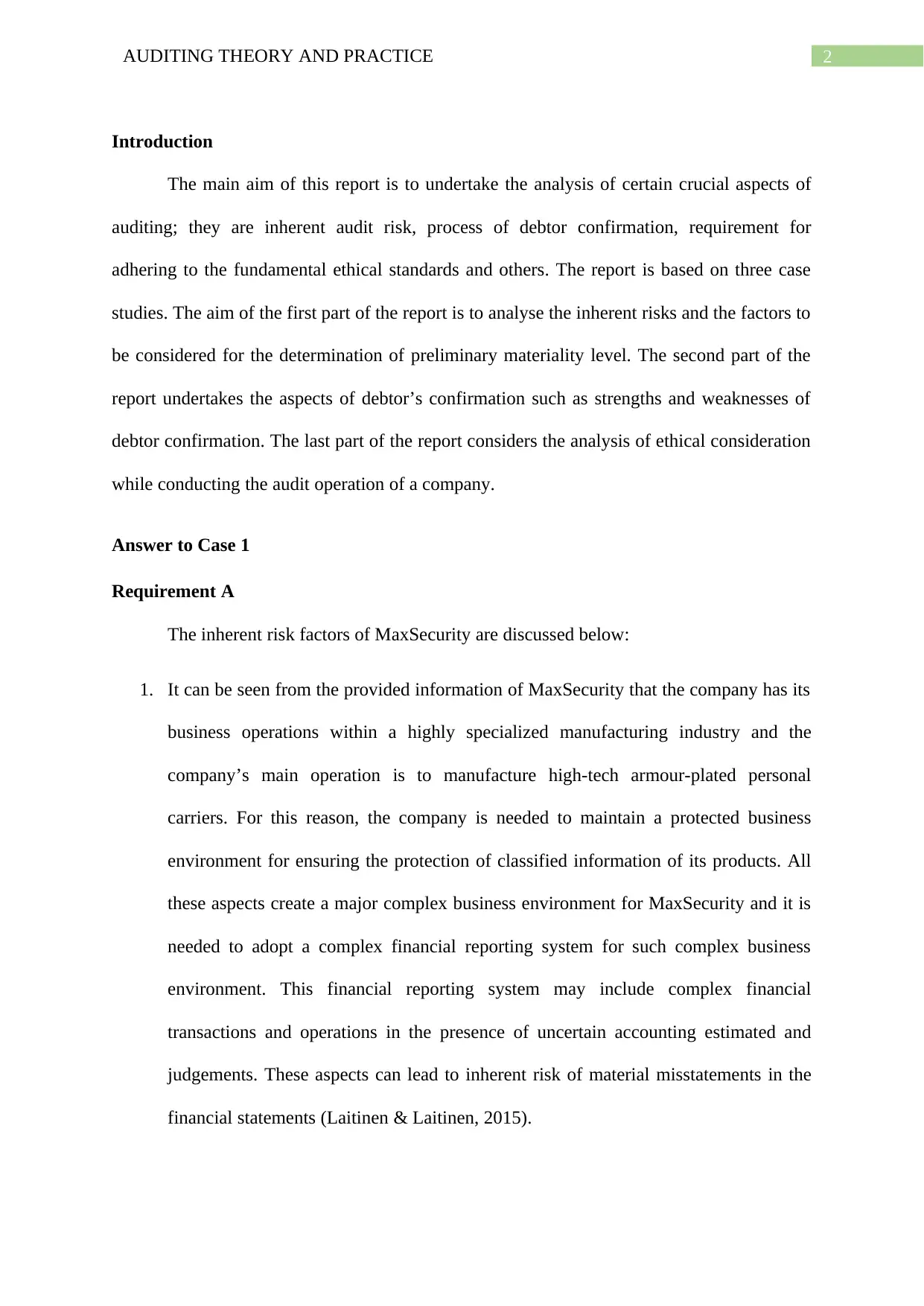
2AUDITING THEORY AND PRACTICE
Introduction
The main aim of this report is to undertake the analysis of certain crucial aspects of
auditing; they are inherent audit risk, process of debtor confirmation, requirement for
adhering to the fundamental ethical standards and others. The report is based on three case
studies. The aim of the first part of the report is to analyse the inherent risks and the factors to
be considered for the determination of preliminary materiality level. The second part of the
report undertakes the aspects of debtor’s confirmation such as strengths and weaknesses of
debtor confirmation. The last part of the report considers the analysis of ethical consideration
while conducting the audit operation of a company.
Answer to Case 1
Requirement A
The inherent risk factors of MaxSecurity are discussed below:
1. It can be seen from the provided information of MaxSecurity that the company has its
business operations within a highly specialized manufacturing industry and the
company’s main operation is to manufacture high-tech armour-plated personal
carriers. For this reason, the company is needed to maintain a protected business
environment for ensuring the protection of classified information of its products. All
these aspects create a major complex business environment for MaxSecurity and it is
needed to adopt a complex financial reporting system for such complex business
environment. This financial reporting system may include complex financial
transactions and operations in the presence of uncertain accounting estimated and
judgements. These aspects can lead to inherent risk of material misstatements in the
financial statements (Laitinen & Laitinen, 2015).
Introduction
The main aim of this report is to undertake the analysis of certain crucial aspects of
auditing; they are inherent audit risk, process of debtor confirmation, requirement for
adhering to the fundamental ethical standards and others. The report is based on three case
studies. The aim of the first part of the report is to analyse the inherent risks and the factors to
be considered for the determination of preliminary materiality level. The second part of the
report undertakes the aspects of debtor’s confirmation such as strengths and weaknesses of
debtor confirmation. The last part of the report considers the analysis of ethical consideration
while conducting the audit operation of a company.
Answer to Case 1
Requirement A
The inherent risk factors of MaxSecurity are discussed below:
1. It can be seen from the provided information of MaxSecurity that the company has its
business operations within a highly specialized manufacturing industry and the
company’s main operation is to manufacture high-tech armour-plated personal
carriers. For this reason, the company is needed to maintain a protected business
environment for ensuring the protection of classified information of its products. All
these aspects create a major complex business environment for MaxSecurity and it is
needed to adopt a complex financial reporting system for such complex business
environment. This financial reporting system may include complex financial
transactions and operations in the presence of uncertain accounting estimated and
judgements. These aspects can lead to inherent risk of material misstatements in the
financial statements (Laitinen & Laitinen, 2015).
⊘ This is a preview!⊘
Do you want full access?
Subscribe today to unlock all pages.

Trusted by 1+ million students worldwide
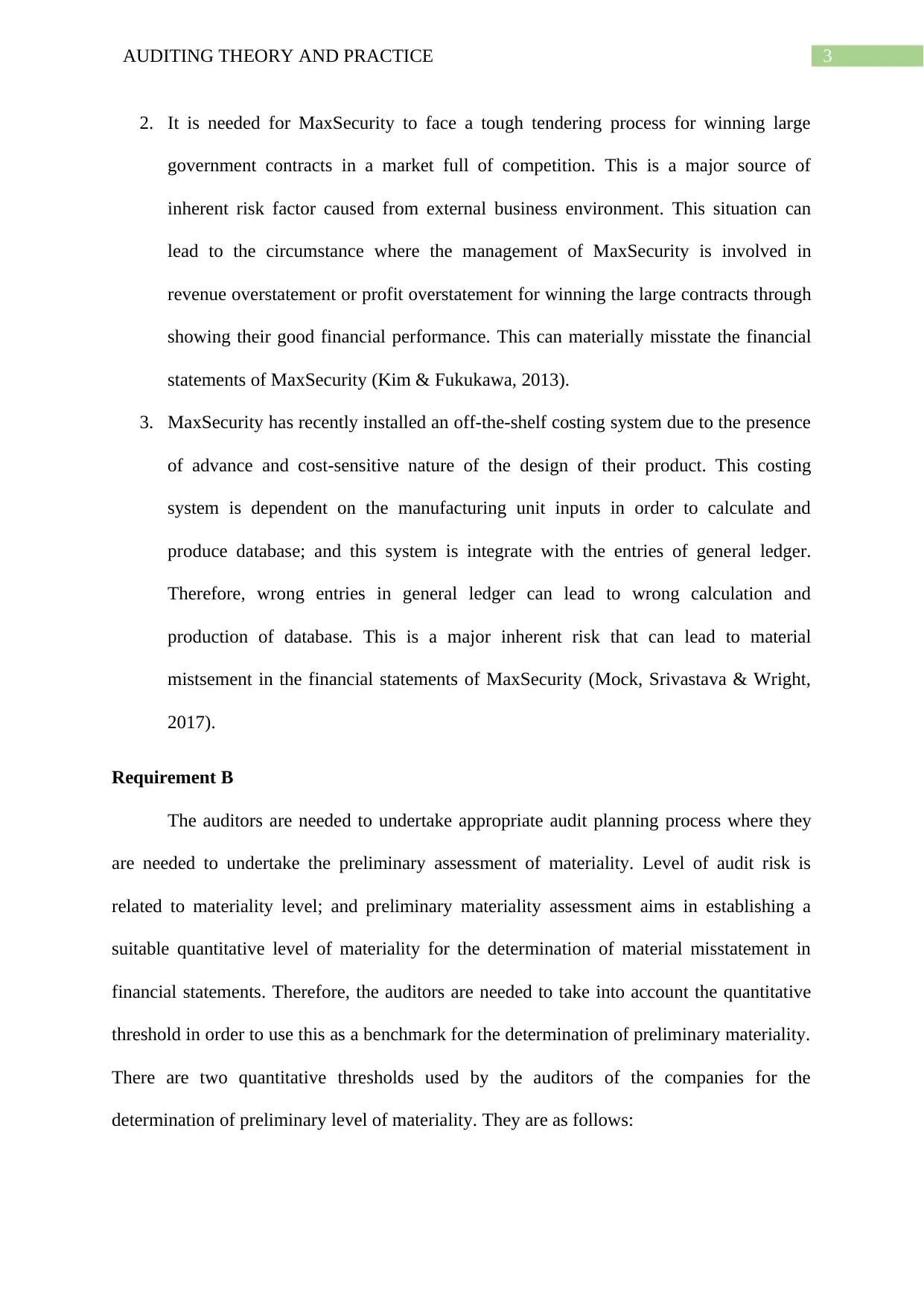
3AUDITING THEORY AND PRACTICE
2. It is needed for MaxSecurity to face a tough tendering process for winning large
government contracts in a market full of competition. This is a major source of
inherent risk factor caused from external business environment. This situation can
lead to the circumstance where the management of MaxSecurity is involved in
revenue overstatement or profit overstatement for winning the large contracts through
showing their good financial performance. This can materially misstate the financial
statements of MaxSecurity (Kim & Fukukawa, 2013).
3. MaxSecurity has recently installed an off-the-shelf costing system due to the presence
of advance and cost-sensitive nature of the design of their product. This costing
system is dependent on the manufacturing unit inputs in order to calculate and
produce database; and this system is integrate with the entries of general ledger.
Therefore, wrong entries in general ledger can lead to wrong calculation and
production of database. This is a major inherent risk that can lead to material
mistsement in the financial statements of MaxSecurity (Mock, Srivastava & Wright,
2017).
Requirement B
The auditors are needed to undertake appropriate audit planning process where they
are needed to undertake the preliminary assessment of materiality. Level of audit risk is
related to materiality level; and preliminary materiality assessment aims in establishing a
suitable quantitative level of materiality for the determination of material misstatement in
financial statements. Therefore, the auditors are needed to take into account the quantitative
threshold in order to use this as a benchmark for the determination of preliminary materiality.
There are two quantitative thresholds used by the auditors of the companies for the
determination of preliminary level of materiality. They are as follows:
2. It is needed for MaxSecurity to face a tough tendering process for winning large
government contracts in a market full of competition. This is a major source of
inherent risk factor caused from external business environment. This situation can
lead to the circumstance where the management of MaxSecurity is involved in
revenue overstatement or profit overstatement for winning the large contracts through
showing their good financial performance. This can materially misstate the financial
statements of MaxSecurity (Kim & Fukukawa, 2013).
3. MaxSecurity has recently installed an off-the-shelf costing system due to the presence
of advance and cost-sensitive nature of the design of their product. This costing
system is dependent on the manufacturing unit inputs in order to calculate and
produce database; and this system is integrate with the entries of general ledger.
Therefore, wrong entries in general ledger can lead to wrong calculation and
production of database. This is a major inherent risk that can lead to material
mistsement in the financial statements of MaxSecurity (Mock, Srivastava & Wright,
2017).
Requirement B
The auditors are needed to undertake appropriate audit planning process where they
are needed to undertake the preliminary assessment of materiality. Level of audit risk is
related to materiality level; and preliminary materiality assessment aims in establishing a
suitable quantitative level of materiality for the determination of material misstatement in
financial statements. Therefore, the auditors are needed to take into account the quantitative
threshold in order to use this as a benchmark for the determination of preliminary materiality.
There are two quantitative thresholds used by the auditors of the companies for the
determination of preliminary level of materiality. They are as follows:
Paraphrase This Document
Need a fresh take? Get an instant paraphrase of this document with our AI Paraphraser
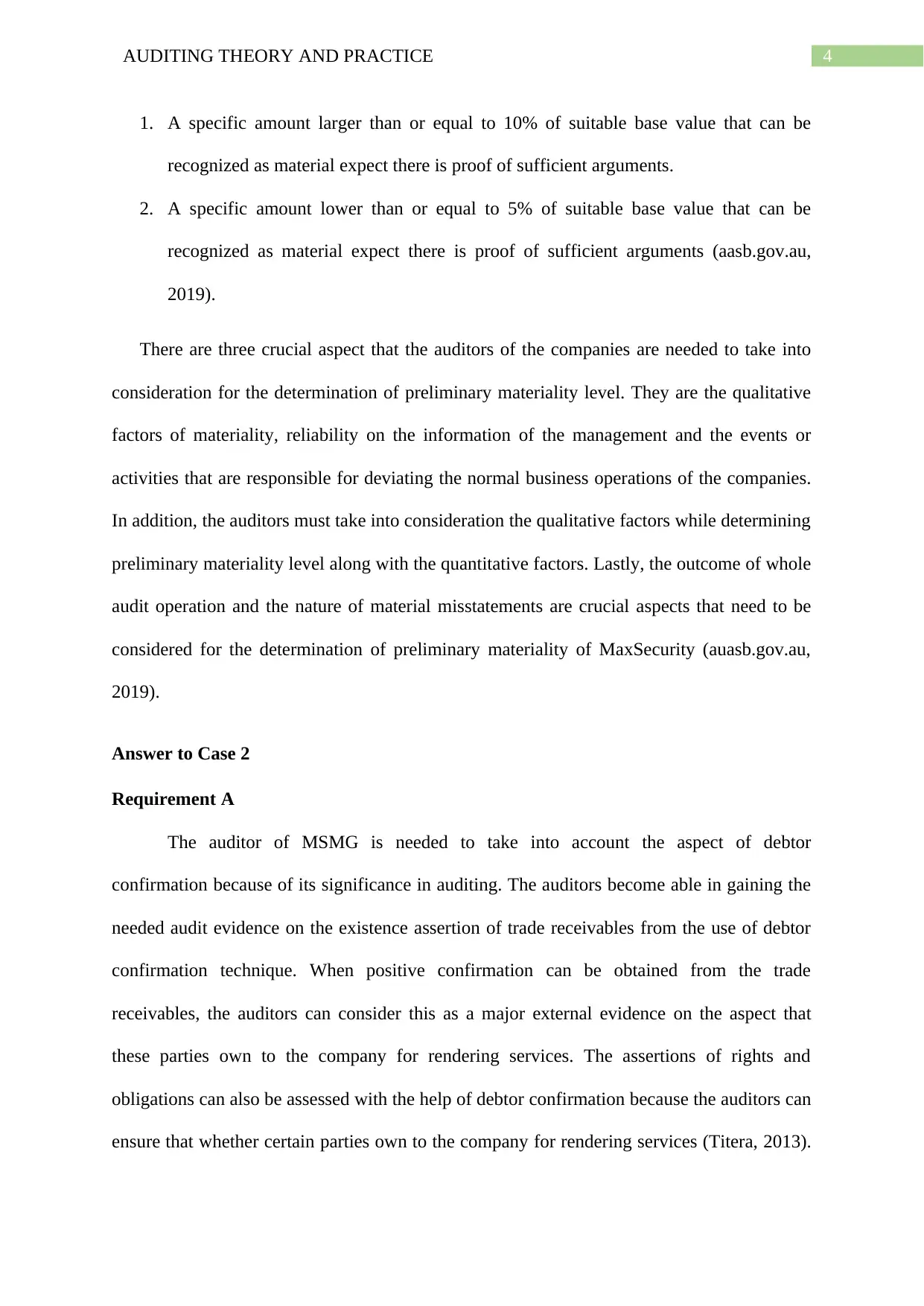
4AUDITING THEORY AND PRACTICE
1. A specific amount larger than or equal to 10% of suitable base value that can be
recognized as material expect there is proof of sufficient arguments.
2. A specific amount lower than or equal to 5% of suitable base value that can be
recognized as material expect there is proof of sufficient arguments (aasb.gov.au,
2019).
There are three crucial aspect that the auditors of the companies are needed to take into
consideration for the determination of preliminary materiality level. They are the qualitative
factors of materiality, reliability on the information of the management and the events or
activities that are responsible for deviating the normal business operations of the companies.
In addition, the auditors must take into consideration the qualitative factors while determining
preliminary materiality level along with the quantitative factors. Lastly, the outcome of whole
audit operation and the nature of material misstatements are crucial aspects that need to be
considered for the determination of preliminary materiality of MaxSecurity (auasb.gov.au,
2019).
Answer to Case 2
Requirement A
The auditor of MSMG is needed to take into account the aspect of debtor
confirmation because of its significance in auditing. The auditors become able in gaining the
needed audit evidence on the existence assertion of trade receivables from the use of debtor
confirmation technique. When positive confirmation can be obtained from the trade
receivables, the auditors can consider this as a major external evidence on the aspect that
these parties own to the company for rendering services. The assertions of rights and
obligations can also be assessed with the help of debtor confirmation because the auditors can
ensure that whether certain parties own to the company for rendering services (Titera, 2013).
1. A specific amount larger than or equal to 10% of suitable base value that can be
recognized as material expect there is proof of sufficient arguments.
2. A specific amount lower than or equal to 5% of suitable base value that can be
recognized as material expect there is proof of sufficient arguments (aasb.gov.au,
2019).
There are three crucial aspect that the auditors of the companies are needed to take into
consideration for the determination of preliminary materiality level. They are the qualitative
factors of materiality, reliability on the information of the management and the events or
activities that are responsible for deviating the normal business operations of the companies.
In addition, the auditors must take into consideration the qualitative factors while determining
preliminary materiality level along with the quantitative factors. Lastly, the outcome of whole
audit operation and the nature of material misstatements are crucial aspects that need to be
considered for the determination of preliminary materiality of MaxSecurity (auasb.gov.au,
2019).
Answer to Case 2
Requirement A
The auditor of MSMG is needed to take into account the aspect of debtor
confirmation because of its significance in auditing. The auditors become able in gaining the
needed audit evidence on the existence assertion of trade receivables from the use of debtor
confirmation technique. When positive confirmation can be obtained from the trade
receivables, the auditors can consider this as a major external evidence on the aspect that
these parties own to the company for rendering services. The assertions of rights and
obligations can also be assessed with the help of debtor confirmation because the auditors can
ensure that whether certain parties own to the company for rendering services (Titera, 2013).
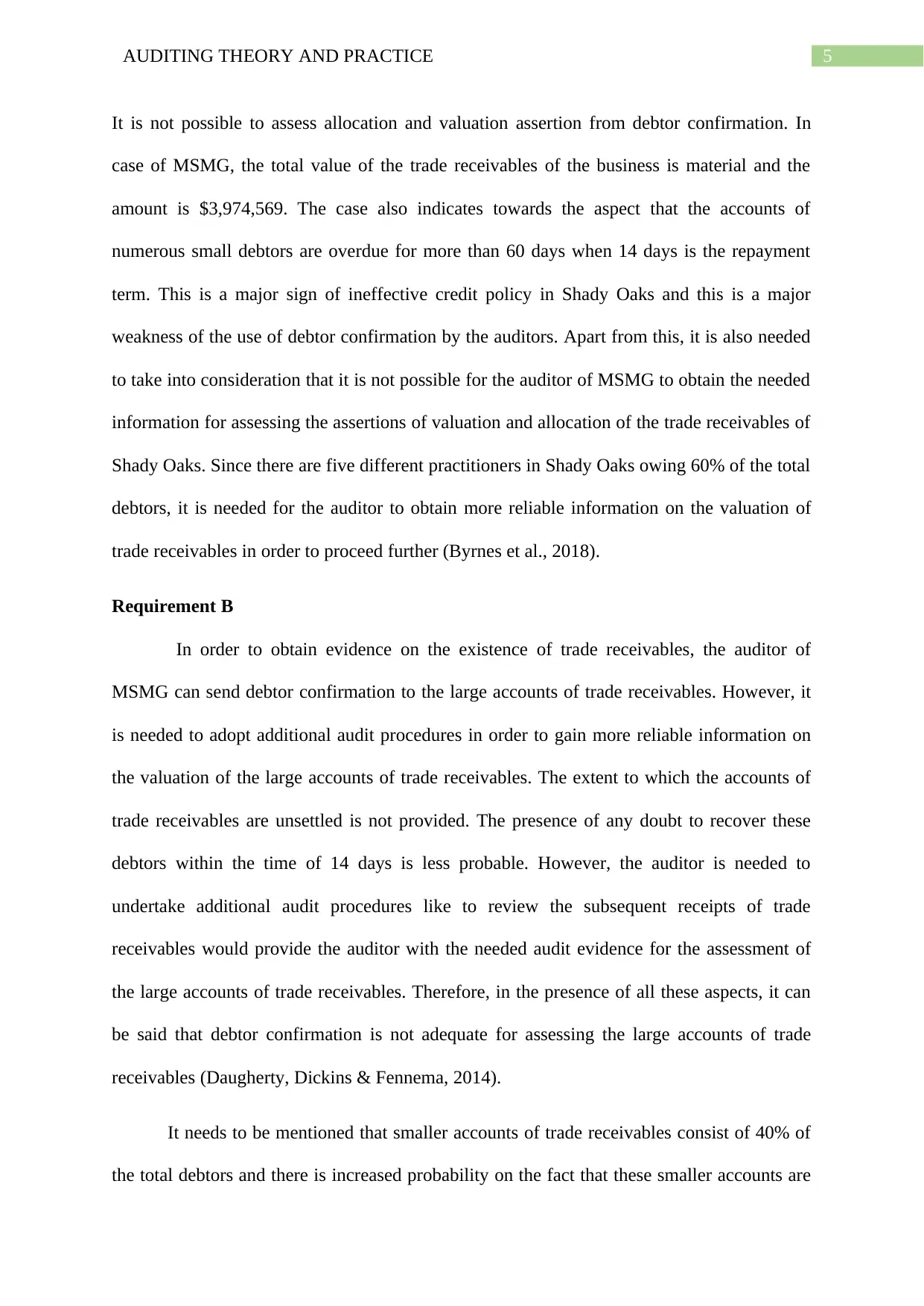
5AUDITING THEORY AND PRACTICE
It is not possible to assess allocation and valuation assertion from debtor confirmation. In
case of MSMG, the total value of the trade receivables of the business is material and the
amount is $3,974,569. The case also indicates towards the aspect that the accounts of
numerous small debtors are overdue for more than 60 days when 14 days is the repayment
term. This is a major sign of ineffective credit policy in Shady Oaks and this is a major
weakness of the use of debtor confirmation by the auditors. Apart from this, it is also needed
to take into consideration that it is not possible for the auditor of MSMG to obtain the needed
information for assessing the assertions of valuation and allocation of the trade receivables of
Shady Oaks. Since there are five different practitioners in Shady Oaks owing 60% of the total
debtors, it is needed for the auditor to obtain more reliable information on the valuation of
trade receivables in order to proceed further (Byrnes et al., 2018).
Requirement B
In order to obtain evidence on the existence of trade receivables, the auditor of
MSMG can send debtor confirmation to the large accounts of trade receivables. However, it
is needed to adopt additional audit procedures in order to gain more reliable information on
the valuation of the large accounts of trade receivables. The extent to which the accounts of
trade receivables are unsettled is not provided. The presence of any doubt to recover these
debtors within the time of 14 days is less probable. However, the auditor is needed to
undertake additional audit procedures like to review the subsequent receipts of trade
receivables would provide the auditor with the needed audit evidence for the assessment of
the large accounts of trade receivables. Therefore, in the presence of all these aspects, it can
be said that debtor confirmation is not adequate for assessing the large accounts of trade
receivables (Daugherty, Dickins & Fennema, 2014).
It needs to be mentioned that smaller accounts of trade receivables consist of 40% of
the total debtors and there is increased probability on the fact that these smaller accounts are
It is not possible to assess allocation and valuation assertion from debtor confirmation. In
case of MSMG, the total value of the trade receivables of the business is material and the
amount is $3,974,569. The case also indicates towards the aspect that the accounts of
numerous small debtors are overdue for more than 60 days when 14 days is the repayment
term. This is a major sign of ineffective credit policy in Shady Oaks and this is a major
weakness of the use of debtor confirmation by the auditors. Apart from this, it is also needed
to take into consideration that it is not possible for the auditor of MSMG to obtain the needed
information for assessing the assertions of valuation and allocation of the trade receivables of
Shady Oaks. Since there are five different practitioners in Shady Oaks owing 60% of the total
debtors, it is needed for the auditor to obtain more reliable information on the valuation of
trade receivables in order to proceed further (Byrnes et al., 2018).
Requirement B
In order to obtain evidence on the existence of trade receivables, the auditor of
MSMG can send debtor confirmation to the large accounts of trade receivables. However, it
is needed to adopt additional audit procedures in order to gain more reliable information on
the valuation of the large accounts of trade receivables. The extent to which the accounts of
trade receivables are unsettled is not provided. The presence of any doubt to recover these
debtors within the time of 14 days is less probable. However, the auditor is needed to
undertake additional audit procedures like to review the subsequent receipts of trade
receivables would provide the auditor with the needed audit evidence for the assessment of
the large accounts of trade receivables. Therefore, in the presence of all these aspects, it can
be said that debtor confirmation is not adequate for assessing the large accounts of trade
receivables (Daugherty, Dickins & Fennema, 2014).
It needs to be mentioned that smaller accounts of trade receivables consist of 40% of
the total debtors and there is increased probability on the fact that these smaller accounts are
⊘ This is a preview!⊘
Do you want full access?
Subscribe today to unlock all pages.

Trusted by 1+ million students worldwide
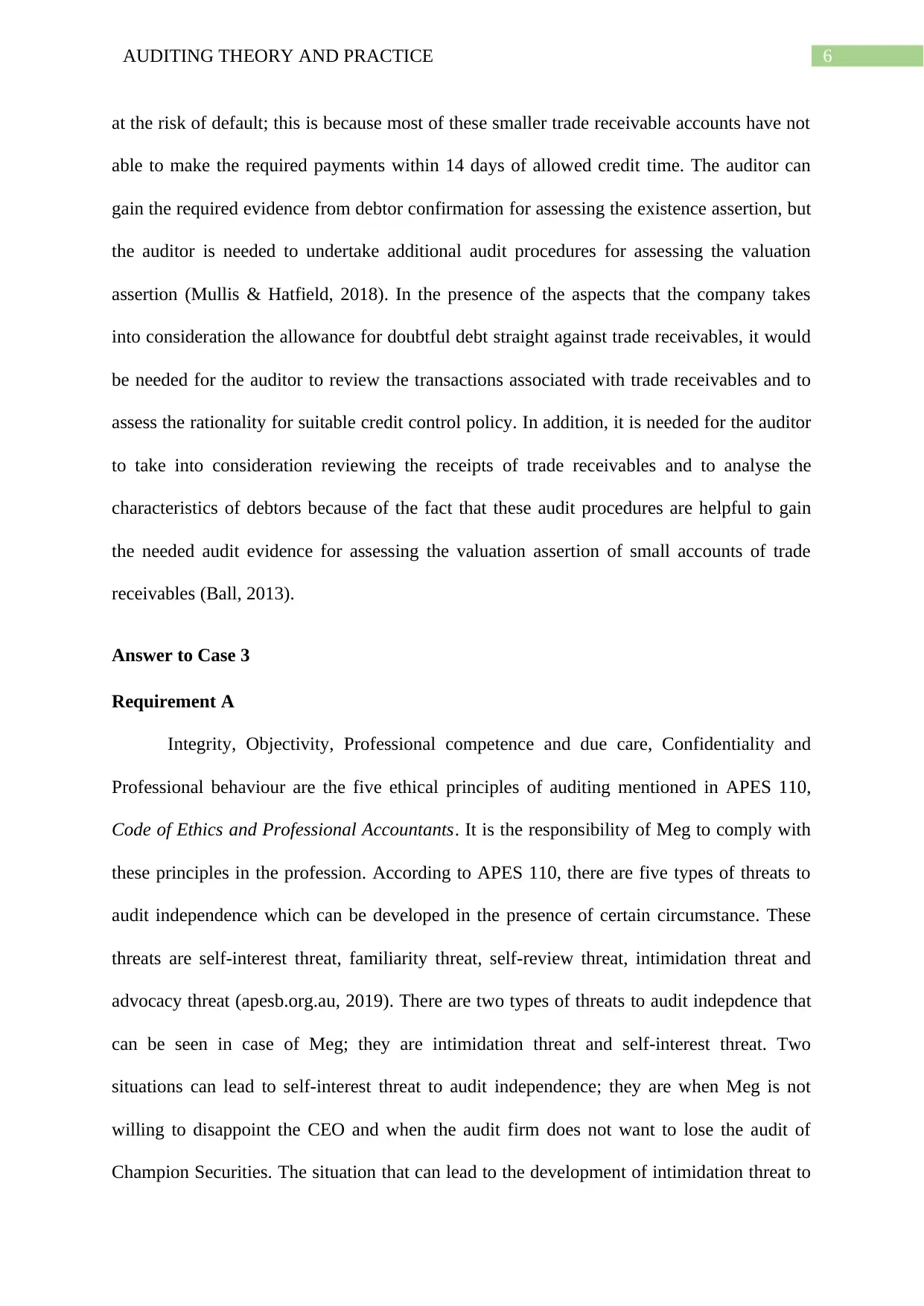
6AUDITING THEORY AND PRACTICE
at the risk of default; this is because most of these smaller trade receivable accounts have not
able to make the required payments within 14 days of allowed credit time. The auditor can
gain the required evidence from debtor confirmation for assessing the existence assertion, but
the auditor is needed to undertake additional audit procedures for assessing the valuation
assertion (Mullis & Hatfield, 2018). In the presence of the aspects that the company takes
into consideration the allowance for doubtful debt straight against trade receivables, it would
be needed for the auditor to review the transactions associated with trade receivables and to
assess the rationality for suitable credit control policy. In addition, it is needed for the auditor
to take into consideration reviewing the receipts of trade receivables and to analyse the
characteristics of debtors because of the fact that these audit procedures are helpful to gain
the needed audit evidence for assessing the valuation assertion of small accounts of trade
receivables (Ball, 2013).
Answer to Case 3
Requirement A
Integrity, Objectivity, Professional competence and due care, Confidentiality and
Professional behaviour are the five ethical principles of auditing mentioned in APES 110,
Code of Ethics and Professional Accountants. It is the responsibility of Meg to comply with
these principles in the profession. According to APES 110, there are five types of threats to
audit independence which can be developed in the presence of certain circumstance. These
threats are self-interest threat, familiarity threat, self-review threat, intimidation threat and
advocacy threat (apesb.org.au, 2019). There are two types of threats to audit indepdence that
can be seen in case of Meg; they are intimidation threat and self-interest threat. Two
situations can lead to self-interest threat to audit independence; they are when Meg is not
willing to disappoint the CEO and when the audit firm does not want to lose the audit of
Champion Securities. The situation that can lead to the development of intimidation threat to
at the risk of default; this is because most of these smaller trade receivable accounts have not
able to make the required payments within 14 days of allowed credit time. The auditor can
gain the required evidence from debtor confirmation for assessing the existence assertion, but
the auditor is needed to undertake additional audit procedures for assessing the valuation
assertion (Mullis & Hatfield, 2018). In the presence of the aspects that the company takes
into consideration the allowance for doubtful debt straight against trade receivables, it would
be needed for the auditor to review the transactions associated with trade receivables and to
assess the rationality for suitable credit control policy. In addition, it is needed for the auditor
to take into consideration reviewing the receipts of trade receivables and to analyse the
characteristics of debtors because of the fact that these audit procedures are helpful to gain
the needed audit evidence for assessing the valuation assertion of small accounts of trade
receivables (Ball, 2013).
Answer to Case 3
Requirement A
Integrity, Objectivity, Professional competence and due care, Confidentiality and
Professional behaviour are the five ethical principles of auditing mentioned in APES 110,
Code of Ethics and Professional Accountants. It is the responsibility of Meg to comply with
these principles in the profession. According to APES 110, there are five types of threats to
audit independence which can be developed in the presence of certain circumstance. These
threats are self-interest threat, familiarity threat, self-review threat, intimidation threat and
advocacy threat (apesb.org.au, 2019). There are two types of threats to audit indepdence that
can be seen in case of Meg; they are intimidation threat and self-interest threat. Two
situations can lead to self-interest threat to audit independence; they are when Meg is not
willing to disappoint the CEO and when the audit firm does not want to lose the audit of
Champion Securities. The situation that can lead to the development of intimidation threat to
Paraphrase This Document
Need a fresh take? Get an instant paraphrase of this document with our AI Paraphraser
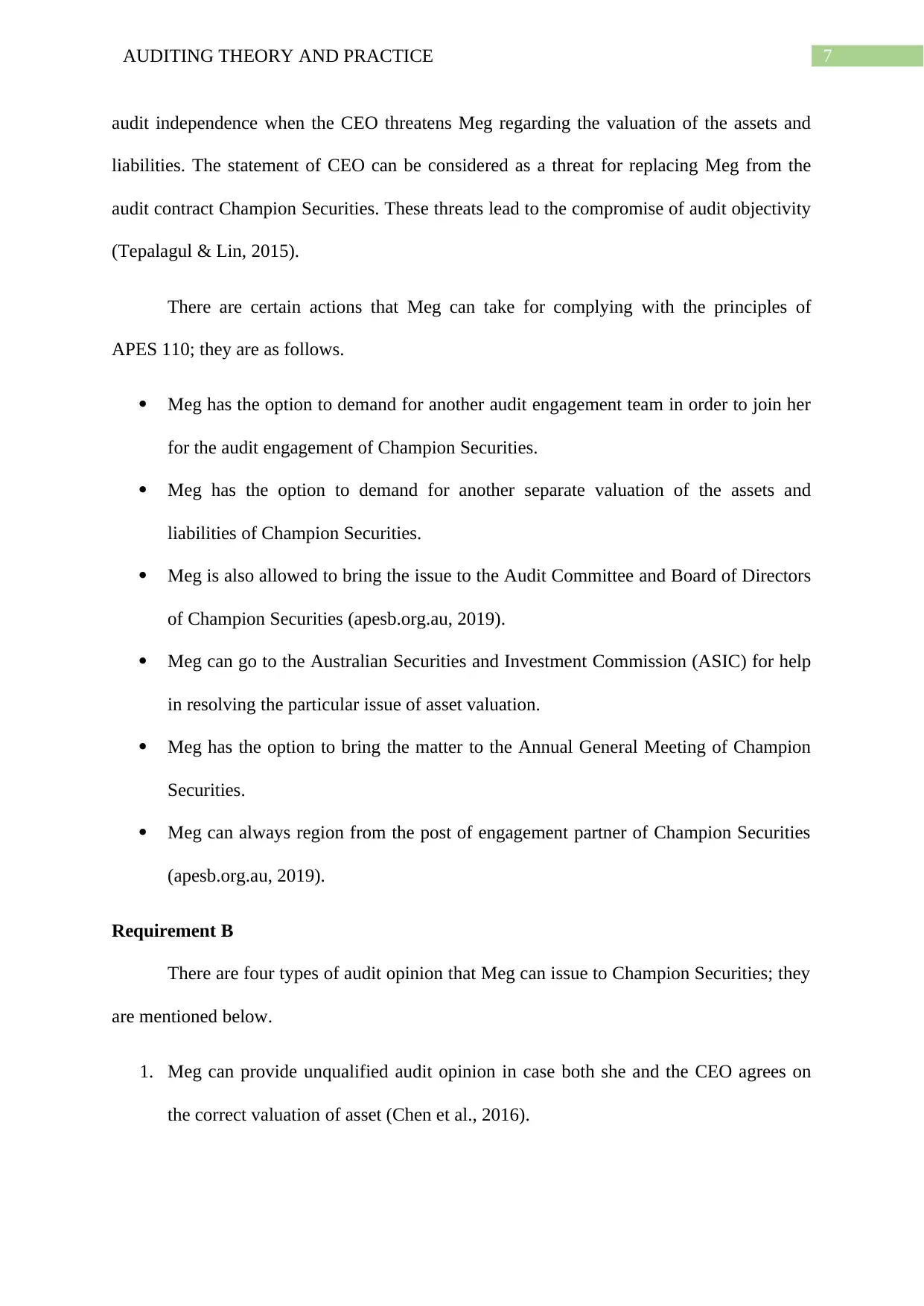
7AUDITING THEORY AND PRACTICE
audit independence when the CEO threatens Meg regarding the valuation of the assets and
liabilities. The statement of CEO can be considered as a threat for replacing Meg from the
audit contract Champion Securities. These threats lead to the compromise of audit objectivity
(Tepalagul & Lin, 2015).
There are certain actions that Meg can take for complying with the principles of
APES 110; they are as follows.
Meg has the option to demand for another audit engagement team in order to join her
for the audit engagement of Champion Securities.
Meg has the option to demand for another separate valuation of the assets and
liabilities of Champion Securities.
Meg is also allowed to bring the issue to the Audit Committee and Board of Directors
of Champion Securities (apesb.org.au, 2019).
Meg can go to the Australian Securities and Investment Commission (ASIC) for help
in resolving the particular issue of asset valuation.
Meg has the option to bring the matter to the Annual General Meeting of Champion
Securities.
Meg can always region from the post of engagement partner of Champion Securities
(apesb.org.au, 2019).
Requirement B
There are four types of audit opinion that Meg can issue to Champion Securities; they
are mentioned below.
1. Meg can provide unqualified audit opinion in case both she and the CEO agrees on
the correct valuation of asset (Chen et al., 2016).
audit independence when the CEO threatens Meg regarding the valuation of the assets and
liabilities. The statement of CEO can be considered as a threat for replacing Meg from the
audit contract Champion Securities. These threats lead to the compromise of audit objectivity
(Tepalagul & Lin, 2015).
There are certain actions that Meg can take for complying with the principles of
APES 110; they are as follows.
Meg has the option to demand for another audit engagement team in order to join her
for the audit engagement of Champion Securities.
Meg has the option to demand for another separate valuation of the assets and
liabilities of Champion Securities.
Meg is also allowed to bring the issue to the Audit Committee and Board of Directors
of Champion Securities (apesb.org.au, 2019).
Meg can go to the Australian Securities and Investment Commission (ASIC) for help
in resolving the particular issue of asset valuation.
Meg has the option to bring the matter to the Annual General Meeting of Champion
Securities.
Meg can always region from the post of engagement partner of Champion Securities
(apesb.org.au, 2019).
Requirement B
There are four types of audit opinion that Meg can issue to Champion Securities; they
are mentioned below.
1. Meg can provide unqualified audit opinion in case both she and the CEO agrees on
the correct valuation of asset (Chen et al., 2016).
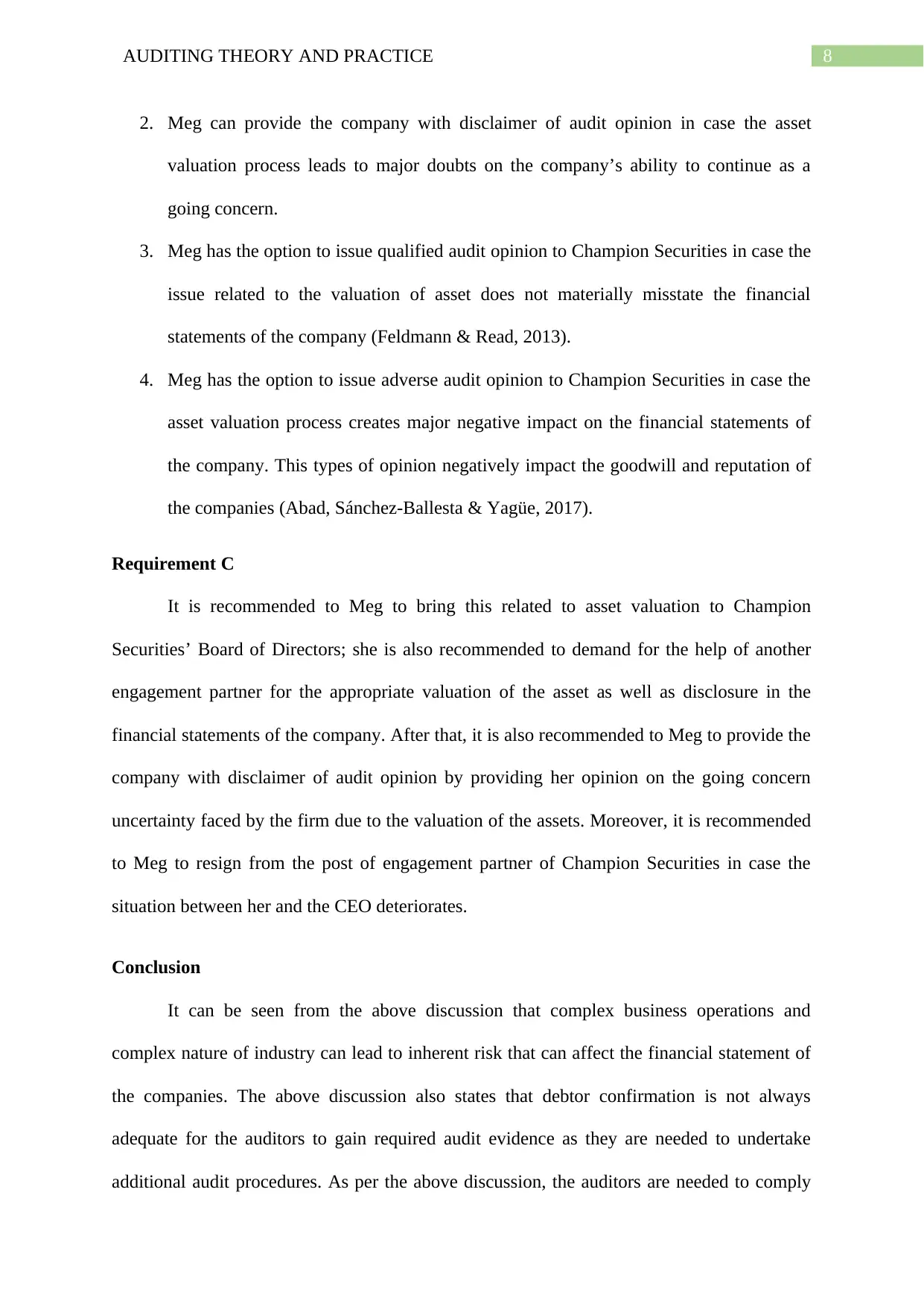
8AUDITING THEORY AND PRACTICE
2. Meg can provide the company with disclaimer of audit opinion in case the asset
valuation process leads to major doubts on the company’s ability to continue as a
going concern.
3. Meg has the option to issue qualified audit opinion to Champion Securities in case the
issue related to the valuation of asset does not materially misstate the financial
statements of the company (Feldmann & Read, 2013).
4. Meg has the option to issue adverse audit opinion to Champion Securities in case the
asset valuation process creates major negative impact on the financial statements of
the company. This types of opinion negatively impact the goodwill and reputation of
the companies (Abad, Sánchez‐Ballesta & Yagüe, 2017).
Requirement C
It is recommended to Meg to bring this related to asset valuation to Champion
Securities’ Board of Directors; she is also recommended to demand for the help of another
engagement partner for the appropriate valuation of the asset as well as disclosure in the
financial statements of the company. After that, it is also recommended to Meg to provide the
company with disclaimer of audit opinion by providing her opinion on the going concern
uncertainty faced by the firm due to the valuation of the assets. Moreover, it is recommended
to Meg to resign from the post of engagement partner of Champion Securities in case the
situation between her and the CEO deteriorates.
Conclusion
It can be seen from the above discussion that complex business operations and
complex nature of industry can lead to inherent risk that can affect the financial statement of
the companies. The above discussion also states that debtor confirmation is not always
adequate for the auditors to gain required audit evidence as they are needed to undertake
additional audit procedures. As per the above discussion, the auditors are needed to comply
2. Meg can provide the company with disclaimer of audit opinion in case the asset
valuation process leads to major doubts on the company’s ability to continue as a
going concern.
3. Meg has the option to issue qualified audit opinion to Champion Securities in case the
issue related to the valuation of asset does not materially misstate the financial
statements of the company (Feldmann & Read, 2013).
4. Meg has the option to issue adverse audit opinion to Champion Securities in case the
asset valuation process creates major negative impact on the financial statements of
the company. This types of opinion negatively impact the goodwill and reputation of
the companies (Abad, Sánchez‐Ballesta & Yagüe, 2017).
Requirement C
It is recommended to Meg to bring this related to asset valuation to Champion
Securities’ Board of Directors; she is also recommended to demand for the help of another
engagement partner for the appropriate valuation of the asset as well as disclosure in the
financial statements of the company. After that, it is also recommended to Meg to provide the
company with disclaimer of audit opinion by providing her opinion on the going concern
uncertainty faced by the firm due to the valuation of the assets. Moreover, it is recommended
to Meg to resign from the post of engagement partner of Champion Securities in case the
situation between her and the CEO deteriorates.
Conclusion
It can be seen from the above discussion that complex business operations and
complex nature of industry can lead to inherent risk that can affect the financial statement of
the companies. The above discussion also states that debtor confirmation is not always
adequate for the auditors to gain required audit evidence as they are needed to undertake
additional audit procedures. As per the above discussion, the auditors are needed to comply
⊘ This is a preview!⊘
Do you want full access?
Subscribe today to unlock all pages.

Trusted by 1+ million students worldwide
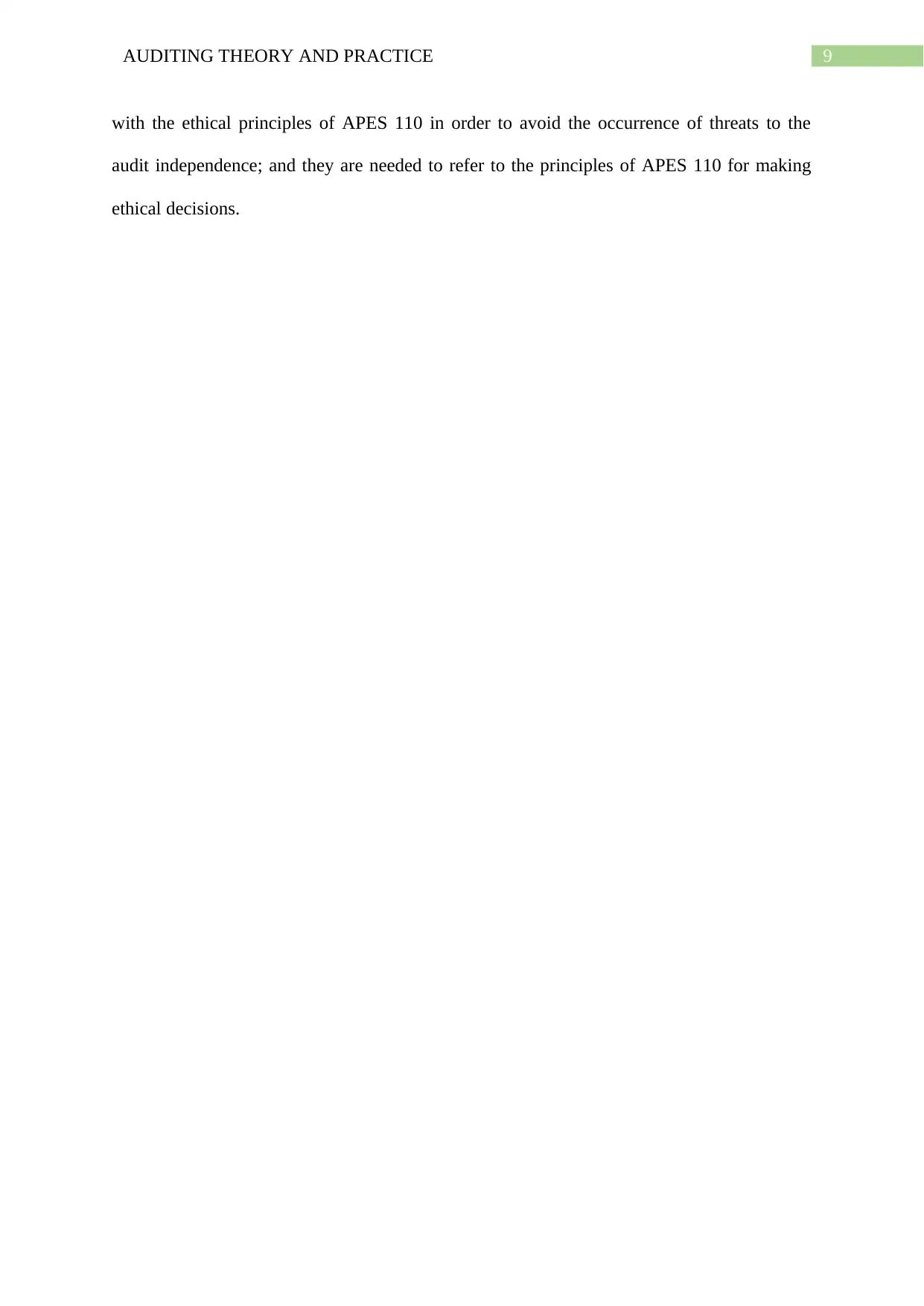
9AUDITING THEORY AND PRACTICE
with the ethical principles of APES 110 in order to avoid the occurrence of threats to the
audit independence; and they are needed to refer to the principles of APES 110 for making
ethical decisions.
with the ethical principles of APES 110 in order to avoid the occurrence of threats to the
audit independence; and they are needed to refer to the principles of APES 110 for making
ethical decisions.
Paraphrase This Document
Need a fresh take? Get an instant paraphrase of this document with our AI Paraphraser
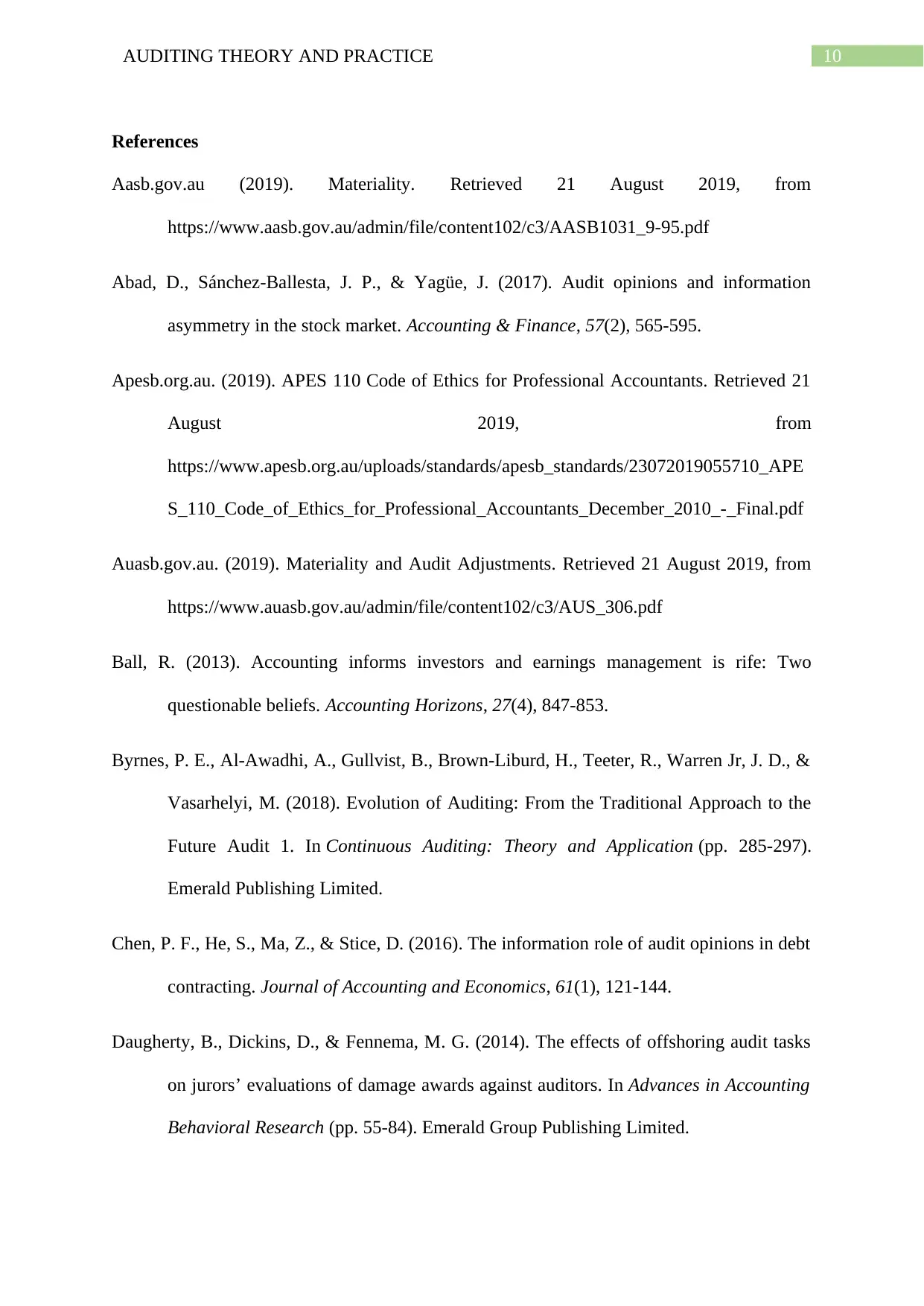
10AUDITING THEORY AND PRACTICE
References
Aasb.gov.au (2019). Materiality. Retrieved 21 August 2019, from
https://www.aasb.gov.au/admin/file/content102/c3/AASB1031_9-95.pdf
Abad, D., Sánchez‐Ballesta, J. P., & Yagüe, J. (2017). Audit opinions and information
asymmetry in the stock market. Accounting & Finance, 57(2), 565-595.
Apesb.org.au. (2019). APES 110 Code of Ethics for Professional Accountants. Retrieved 21
August 2019, from
https://www.apesb.org.au/uploads/standards/apesb_standards/23072019055710_APE
S_110_Code_of_Ethics_for_Professional_Accountants_December_2010_-_Final.pdf
Auasb.gov.au. (2019). Materiality and Audit Adjustments. Retrieved 21 August 2019, from
https://www.auasb.gov.au/admin/file/content102/c3/AUS_306.pdf
Ball, R. (2013). Accounting informs investors and earnings management is rife: Two
questionable beliefs. Accounting Horizons, 27(4), 847-853.
Byrnes, P. E., Al-Awadhi, A., Gullvist, B., Brown-Liburd, H., Teeter, R., Warren Jr, J. D., &
Vasarhelyi, M. (2018). Evolution of Auditing: From the Traditional Approach to the
Future Audit 1. In Continuous Auditing: Theory and Application (pp. 285-297).
Emerald Publishing Limited.
Chen, P. F., He, S., Ma, Z., & Stice, D. (2016). The information role of audit opinions in debt
contracting. Journal of Accounting and Economics, 61(1), 121-144.
Daugherty, B., Dickins, D., & Fennema, M. G. (2014). The effects of offshoring audit tasks
on jurors’ evaluations of damage awards against auditors. In Advances in Accounting
Behavioral Research (pp. 55-84). Emerald Group Publishing Limited.
References
Aasb.gov.au (2019). Materiality. Retrieved 21 August 2019, from
https://www.aasb.gov.au/admin/file/content102/c3/AASB1031_9-95.pdf
Abad, D., Sánchez‐Ballesta, J. P., & Yagüe, J. (2017). Audit opinions and information
asymmetry in the stock market. Accounting & Finance, 57(2), 565-595.
Apesb.org.au. (2019). APES 110 Code of Ethics for Professional Accountants. Retrieved 21
August 2019, from
https://www.apesb.org.au/uploads/standards/apesb_standards/23072019055710_APE
S_110_Code_of_Ethics_for_Professional_Accountants_December_2010_-_Final.pdf
Auasb.gov.au. (2019). Materiality and Audit Adjustments. Retrieved 21 August 2019, from
https://www.auasb.gov.au/admin/file/content102/c3/AUS_306.pdf
Ball, R. (2013). Accounting informs investors and earnings management is rife: Two
questionable beliefs. Accounting Horizons, 27(4), 847-853.
Byrnes, P. E., Al-Awadhi, A., Gullvist, B., Brown-Liburd, H., Teeter, R., Warren Jr, J. D., &
Vasarhelyi, M. (2018). Evolution of Auditing: From the Traditional Approach to the
Future Audit 1. In Continuous Auditing: Theory and Application (pp. 285-297).
Emerald Publishing Limited.
Chen, P. F., He, S., Ma, Z., & Stice, D. (2016). The information role of audit opinions in debt
contracting. Journal of Accounting and Economics, 61(1), 121-144.
Daugherty, B., Dickins, D., & Fennema, M. G. (2014). The effects of offshoring audit tasks
on jurors’ evaluations of damage awards against auditors. In Advances in Accounting
Behavioral Research (pp. 55-84). Emerald Group Publishing Limited.
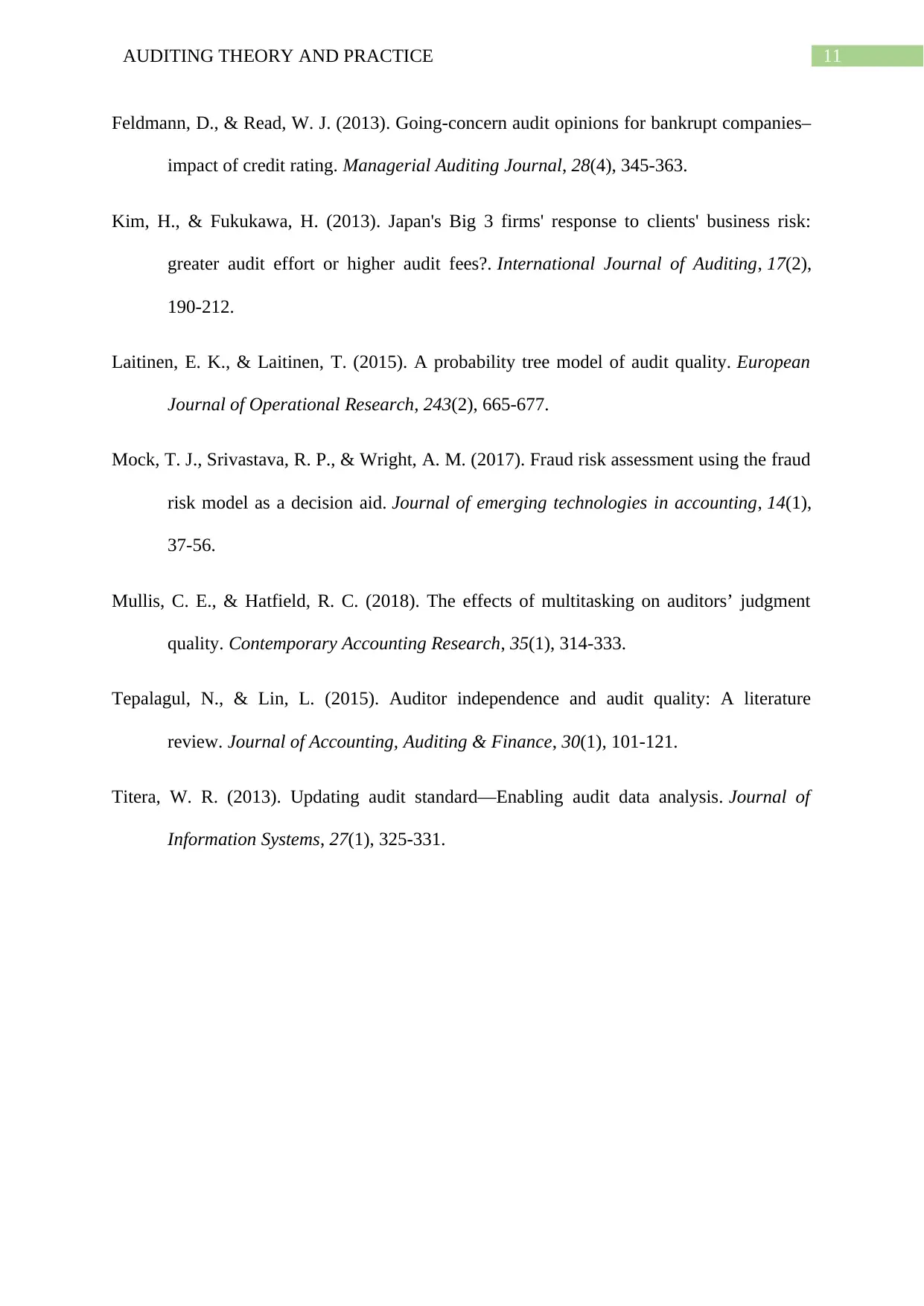
11AUDITING THEORY AND PRACTICE
Feldmann, D., & Read, W. J. (2013). Going-concern audit opinions for bankrupt companies–
impact of credit rating. Managerial Auditing Journal, 28(4), 345-363.
Kim, H., & Fukukawa, H. (2013). Japan's Big 3 firms' response to clients' business risk:
greater audit effort or higher audit fees?. International Journal of Auditing, 17(2),
190-212.
Laitinen, E. K., & Laitinen, T. (2015). A probability tree model of audit quality. European
Journal of Operational Research, 243(2), 665-677.
Mock, T. J., Srivastava, R. P., & Wright, A. M. (2017). Fraud risk assessment using the fraud
risk model as a decision aid. Journal of emerging technologies in accounting, 14(1),
37-56.
Mullis, C. E., & Hatfield, R. C. (2018). The effects of multitasking on auditors’ judgment
quality. Contemporary Accounting Research, 35(1), 314-333.
Tepalagul, N., & Lin, L. (2015). Auditor independence and audit quality: A literature
review. Journal of Accounting, Auditing & Finance, 30(1), 101-121.
Titera, W. R. (2013). Updating audit standard—Enabling audit data analysis. Journal of
Information Systems, 27(1), 325-331.
Feldmann, D., & Read, W. J. (2013). Going-concern audit opinions for bankrupt companies–
impact of credit rating. Managerial Auditing Journal, 28(4), 345-363.
Kim, H., & Fukukawa, H. (2013). Japan's Big 3 firms' response to clients' business risk:
greater audit effort or higher audit fees?. International Journal of Auditing, 17(2),
190-212.
Laitinen, E. K., & Laitinen, T. (2015). A probability tree model of audit quality. European
Journal of Operational Research, 243(2), 665-677.
Mock, T. J., Srivastava, R. P., & Wright, A. M. (2017). Fraud risk assessment using the fraud
risk model as a decision aid. Journal of emerging technologies in accounting, 14(1),
37-56.
Mullis, C. E., & Hatfield, R. C. (2018). The effects of multitasking on auditors’ judgment
quality. Contemporary Accounting Research, 35(1), 314-333.
Tepalagul, N., & Lin, L. (2015). Auditor independence and audit quality: A literature
review. Journal of Accounting, Auditing & Finance, 30(1), 101-121.
Titera, W. R. (2013). Updating audit standard—Enabling audit data analysis. Journal of
Information Systems, 27(1), 325-331.
⊘ This is a preview!⊘
Do you want full access?
Subscribe today to unlock all pages.

Trusted by 1+ million students worldwide
1 out of 12
Related Documents
Your All-in-One AI-Powered Toolkit for Academic Success.
+13062052269
info@desklib.com
Available 24*7 on WhatsApp / Email
![[object Object]](/_next/static/media/star-bottom.7253800d.svg)
Unlock your academic potential
Copyright © 2020–2025 A2Z Services. All Rights Reserved. Developed and managed by ZUCOL.





